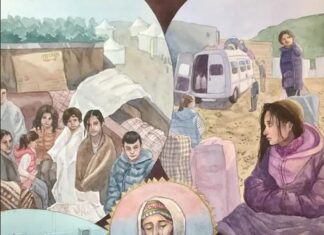WATERTOWN — The Amaras Art Alliance announces the release in English of the popular and celebrated novel, The Book of Adam (Adami girke) by the prolific Armenian writer Hakob Karapents. The inaugural publication of the Amaras Press, a new venture of the Art Alliance, was launched on the organization’s 30th anniversary (2020).
This is the second translation of The Book of Adam. The first translation in Farsi titled, Ketabeh Adam by Andranik Khechoumian, celebrated Iranian Armenian writer, playwright and translator, dedicated to the 95th anniversary of the birth of Hakob Karapents, was released in October 2020.
This English edition of the novel also dedicated to the late inventor, industrialist, humanitarian, philanthropist, and an old friend and patron of Karapents, Sarkis Acopian, and was translated from its original Armenian by Dr. Ara Ghazarians, curator of the Armenian Cultural Foundation of Arlington. In paperback, the book includes an introduction, notes, a glossary and a bibliography of works by the author.
The Book of Adam is Karapents’ second novel, written in 1980 and completed in less than a year and almost a decade after his first novel, The Daughter of Carthage (1972). It has received rave reviews by several Diaspora Armenian writers and literary critiques. It is the winner of the Armenian General Benevolent Union’s (AGBU) Alex Manoogian Literary Award and French-Armenian Writers Society’s Eliz Kavookjian-Ayvazian Literary Award. The second edition of the novel was released in Armenia in 2012. The novel has also been twice adapted for the stage, once in Tehran (2005) in honor of Karapents’ 80th birth anniversary under the direction of Seto Gojamanian, titled “Where Are We to Be Buried” and then in Los Angeles (2017) by Armen Sarvar titled “Yes, Adam Nourian.”
The Book of Adam is constructed on three levels: the state of the American social order in the final decades (1980s) of the 20th century; the current crisis of the Diaspora Armenian; and the crisis of man finding himself at the end of the twentieth century. The characters and plot serve as the means of linking this triad of knots together and reaching a certain truth. “Aside from flashback,” as observed by the late editor, writer and translator Aris Sevag, “the book is written to understand life by the return trip and to live life by the road ahead, the metaphysical with the real, sometimes relying on non-existent realities which are more powerful than the real; therefore, from tie to tie, there surfaces a dry journalistic style to produce a clash between tangible and intangible realities. From this standpoint, the Book of Adam enters the self-contained current of contemporary American literature, which is a sad and nondescript visit to solitary persons and solitary communities.”
Copies of the book are available for purchase by visiting amarasonline.com, the Armenian Prelacy Bookstore in New York and Abril Bookstore in Los Angeles.









